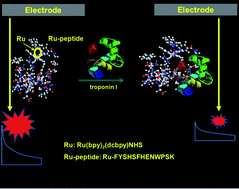Homogeneous electrogenerated chemiluminescencepeptide-based method for determination of troponin I†
Abstract
A novel homogeneous

* Corresponding authors
a
Key Laboratory of Analytical Chemistry for Life Science of Shaanxi Province, School of Chemistry and Chemical Engineering, Shaanxi Normal University, Xi'an, P. R. China
E-mail:
honglanqi@snnu.edu.cn
Fax: +86-29-81530727
Tel: +86-29-81530726
A novel homogeneous

 Please wait while we load your content...
Something went wrong. Try again?
Please wait while we load your content...
Something went wrong. Try again?
C. Wang, H. Qi, X. Qiu, Q. Gao and C. Zhang, Anal. Methods, 2012, 4, 2469 DOI: 10.1039/C2AY25389E
To request permission to reproduce material from this article, please go to the Copyright Clearance Center request page.
If you are an author contributing to an RSC publication, you do not need to request permission provided correct acknowledgement is given.
If you are the author of this article, you do not need to request permission to reproduce figures and diagrams provided correct acknowledgement is given. If you want to reproduce the whole article in a third-party publication (excluding your thesis/dissertation for which permission is not required) please go to the Copyright Clearance Center request page.
Read more about how to correctly acknowledge RSC content.
 Fetching data from CrossRef.
Fetching data from CrossRef.
This may take some time to load.
Loading related content
